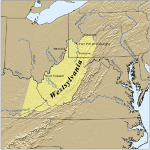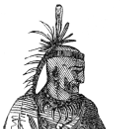The Making of the 50 States: West Virginia
Part 1: In the Beginning
Settlers moving westward through Virginia encountered the Appalachian Mountains. Many moved through the mountains; others settled therein. The English explorer Alexander Spotswood claimed the land for England in 1716. A few years later, Thomas, Lord Fairfax had seen to it that he owned all of the land therein. He then proceeded to sell it. Settlers from Germany, Ireland, the Netherlands, Scotland, and Wales followed. One early settlement was Mecklenburg, which would become Shepherdstown. Trading posts, for furs and other goods, sprung up. The famed explorer Daniel Boone lived in the area for a time. Trade along the Kanawha and Ohio Rivers was brisk. Life among the mountains was rugged. Winters were harsh, and settlers found themselves at odds with Native Americans who had been living in the area exclusively for many years. Still, the settlers of West Virginia enjoyed some amenities. What was then Bath (and is now Berkeley Springs) opened the first public spa in the U.S. in 1756, near a hot springs. British troops built a handful of forts in West Virginia during the French and Indian War. The Battle of Pleasant Point, during Dunmore's War, occurred in 1774 near what is now Point Pleasant; the battle was between Virginia militiamen and members of the Mingo and Shawnee tribes, and the Virginians' victory results in a large land cession by the Native Americans. The area was also the scene of battles and skirmishes during the Revolutionary War. 
What is now West Virginia was, until 1862, part of Virginia, one of the original 13 Colonies and became a state on June 26, 1788. The western part of the state had applied to the Second Continental Congress to break off from the eastern part of Virginia and become what would have then been the 14th state, Westsylvania. The Continental Congress denied the appeal. Next page > The Rest of the Story > Page 1, 2
|
|
Social Studies for Kids
copyright 2002–2024
David White



 As with many other states, some of the early people who lived in what is now West Virginia were from the Mound Builders and Woodland cultures, as well as the Adena and Hopewell peoples. Native Americans known to have lived in West Virginia were the Cherokee, Iroquois, and Manahoac, Meherrin, Monacan, Nottaway, Occaneechi, Saponi, and Shawnee. They grew corn, squash, and sunflowers and hunted bear, bison, deer, geese, and rabbit for food.
As with many other states, some of the early people who lived in what is now West Virginia were from the Mound Builders and Woodland cultures, as well as the Adena and Hopewell peoples. Native Americans known to have lived in West Virginia were the Cherokee, Iroquois, and Manahoac, Meherrin, Monacan, Nottaway, Occaneechi, Saponi, and Shawnee. They grew corn, squash, and sunflowers and hunted bear, bison, deer, geese, and rabbit for food.
